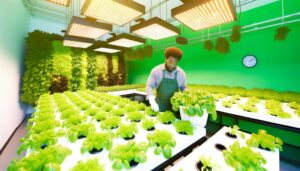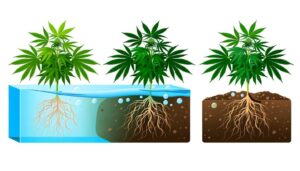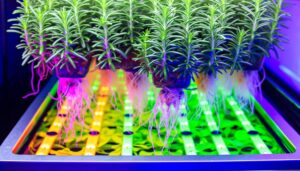Hydroponics Yield Vs Soil Yield
Comparative analyses reveal that hydroponic systems generally yield up to 30% more produce per unit area than traditional soil farming. Hydroponics optimizes nutrient delivery and environmental conditions, leading to growth rates approximately 30% faster and germination rates up to 50% higher than soil cultivation.
Water-use efficiency is also markedly superior in hydroponics, reducing consumption by up to 90%. Precision in nutrient management and minimized pest interference further contribute to enhanced biomass accumulation by up to 50%.
While initial costs are higher, the increased yield and resource efficiency present compelling advantages. For more insights, one might consider examining detailed empirical studies and data.

Key Takeaways
- Hydroponic systems can achieve up to 30% greater yields per unit area compared to soil farming.
- Hydroponics demonstrates growth rates up to 30% faster and germination rates up to 50% quicker than soil farming.
- Hydroponics uses up to 90% less water than traditional soil farming, enhancing water-use efficiency.
- Controlled environments in hydroponics lead to a 40% decrease in pest and disease incidence.
Understanding Hydroponics
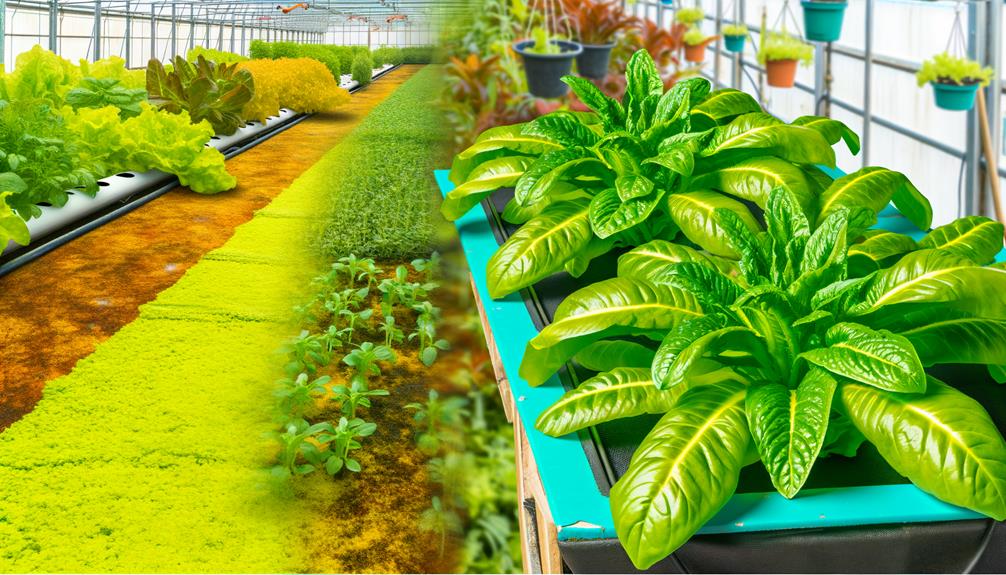
Hydroponics, an advanced method of growing plants without soil by utilizing nutrient-rich water solutions, offers a controlled environment for enhancing plant growth and maximizing yield efficiency.
Key parameters such as pH levels, nutrient concentration, and light exposure are meticulously monitored and adjusted, ensuring ideal conditions for plant development.
Empirical data suggest hydroponic systems can achieve up to 30% faster growth rates and 20-25% higher yields compared to traditional soil farming.
This method mitigates issues related to soil-borne diseases and pests, further enhancing plant health and productivity.
Additionally, hydroponics allows for vertical farming, markedly increasing space utilization.
Basics of Soil Farming
Soil farming, the traditional method of cultivating plants within natural or amended soil, relies on the complex interactions between soil composition, organic matter, and microbial activity to support plant growth and productivity. The efficacy of soil farming is greatly influenced by key parameters such as soil pH, nutrient availability, and water retention capacity. These factors collectively determine the soil's ability to supply essential nutrients and provide a stable growing environment. Soil amendments, such as compost and fertilizers, are often employed to enhance soil structure and nutrient content.
| Factor | Impact on Soil Farming |
|---|---|
| Soil pH | Affects nutrient availability |
| Organic Matter | Improves soil structure |
| Microbial Activity | Enhances nutrient cycling |
Understanding these elements is significant for optimizing soil farming practices.
Growth Rates Compared
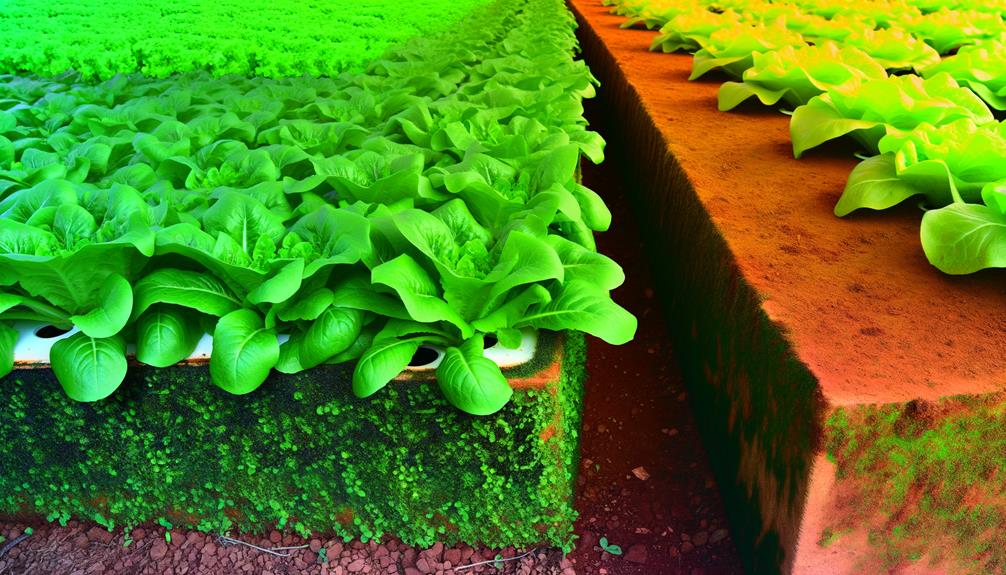
When analyzing growth rates, hydroponics systems often demonstrate accelerated germination speeds and reduced maturation times compared to traditional soil farming.
Empirical data indicates that hydroponics can enhance germination rates by up to 50% and reduce the maturation period by approximately 30%.
These differences are attributed to optimized nutrient delivery and controlled environmental conditions inherent to hydroponic systems.
Germination Speed Differences
Comparing the germination speed of plants in hydroponic systems with those in soil reveals significant differences in growth rates due to variations in nutrient availability and environmental control.
Hydroponic systems offer immediate access to a balanced nutrient solution, optimizing the germination phase. Studies indicate that seeds in hydroponic setups exhibit accelerated germination, with an average time reduction of 20-30% compared to soil-based systems.
This expedited process is attributed to the precise control of factors such as pH, temperature, and moisture levels, which are often suboptimal or inconsistent in traditional soil environments.
Additionally, hydroponic systems mitigate pathogen interference, further enhancing germination rates. Consequently, the controlled conditions inherent in hydroponic cultivation foster a more rapid and uniform seedling emergence.
Maturation Time Comparison
Due to the optimized nutrient delivery and controlled environmental conditions, hydroponic systems generally facilitate faster plant maturation compared to traditional soil-based cultivation.
Empirical studies indicate that hydroponically grown plants often reach maturity 25-30% quicker than their soil-grown counterparts. This acceleration is attributed to the precise regulation of pH, nutrient concentration, and oxygen levels, which optimize root zone conditions and enhance nutrient uptake efficiency.
For instance, leafy greens like lettuce can mature in as little as 30 days in hydroponic systems, compared to 45-60 days in soil.
This reduction in maturation time not only increases the potential for multiple harvest cycles per year but also enhances resource utilization, making hydroponics a compelling choice for maximizing agricultural output.
Yield Potential
Yield potential in hydroponics systems is considerably influenced by the efficiency of nutrient delivery, which guarantees ideal nutrient uptake and minimizes resource wastage.
This controlled nutrient environment can enhance plant growth rates, leading to potentially higher yields compared to traditional soil-based cultivation.
Data indicate that hydroponic systems can achieve up to 30% greater yield per unit area due to these advantages.
Nutrient Delivery Efficiency
The efficiency of nutrient delivery in hydroponic systems can greatly enhance yield potential compared to traditional soil-based cultivation methods.
In hydroponics, nutrients are dissolved in water and delivered directly to plant roots, ensuring ideal absorption rates. Research indicates that hydroponic systems can achieve up to a 30% increase in nutrient uptake efficiency over soil, where nutrient availability is often limited by factors such as soil composition and microbial activity.
This precise control over nutrient concentration and pH levels allows for tailored nutrient regimens that meet the specific needs of each crop. As a result, plants in hydroponic systems often exhibit more robust growth and higher yields, as nutrient deficiencies and imbalances are minimized, thereby maximizing photosynthetic efficiency and overall biomass production.
Plant Growth Rate
An analysis of plant growth rate reveals that hydroponic systems can accelerate biomass accumulation by up to 50% compared to soil-based cultivation, primarily due to optimized nutrient and water delivery mechanisms. This substantial increase in growth rate can be attributed to precise control over nutrient concentrations, pH levels, and oxygenation of the root zone. Empirical data illustrate that hydroponic systems enhance photosynthetic efficiency and reduce water stress, leading to more robust vegetative growth.
| Parameter | Hydroponics | Soil-Based Cultivation |
|---|---|---|
| Growth Rate Increase | Up to 50% | Baseline |
| Nutrient Absorption | Optimized | Variable |
| Water Usage Efficiency | High | Moderate |
| Root Oxygenation | Controlled | Natural |
| Photosynthetic Activity | Enhanced | Standard |
This data underscores the yield potential advantages of hydroponics, making it a compelling choice for maximizing agricultural output.
Nutrient Management

Effectively managing nutrients is essential for optimizing plant growth and achieving higher yields in both hydroponic and soil-based systems.
In hydroponics, nutrients are delivered directly to the plant roots in a controlled solution, allowing for precise adjustments to meet specific plant needs. Studies indicate that hydroponic systems can reduce nutrient waste by up to 50% compared to soil-based systems (Resh, 2013).
Conversely, soil-based cultivation relies on the soil's inherent nutrient content, which can lead to variability in nutrient availability due to factors like pH and microbial activity. Soil amendments and fertilizers are often necessary to compensate for deficiencies, but this can result in less efficient nutrient uptake.
As a result, hydroponics offers superior nutrient management through precision and control.
Water Usage
Hydroponic systems can greatly reduce water usage by up to 90% compared to traditional soil-based cultivation due to the recirculation of nutrient solutions. This efficiency stems from the closed-loop nature of hydroponics, where water loss through evaporation and runoff is minimized. Traditional soil-based methods often result in significant water wastage through percolation and evaporation. Data indicates that hydroponics' water-use efficiency (WUE) is markedly higher than soil-based systems.
| Cultivation Method | Water Usage (Liters/kg Produce) | Water-Use Efficiency (WUE) |
|---|---|---|
| Hydroponics | 20-30 | High |
| Soil-Based | 200-300 | Low |
| Closed-Loop Hydro | 10-15 | Very High |
| Drip Irrigation | 100-150 | Moderate |
| Flood Irrigation | 250-400 | Very Low |
This table underscores the substantial water savings achievable with hydroponic systems.
Pest and Disease Control
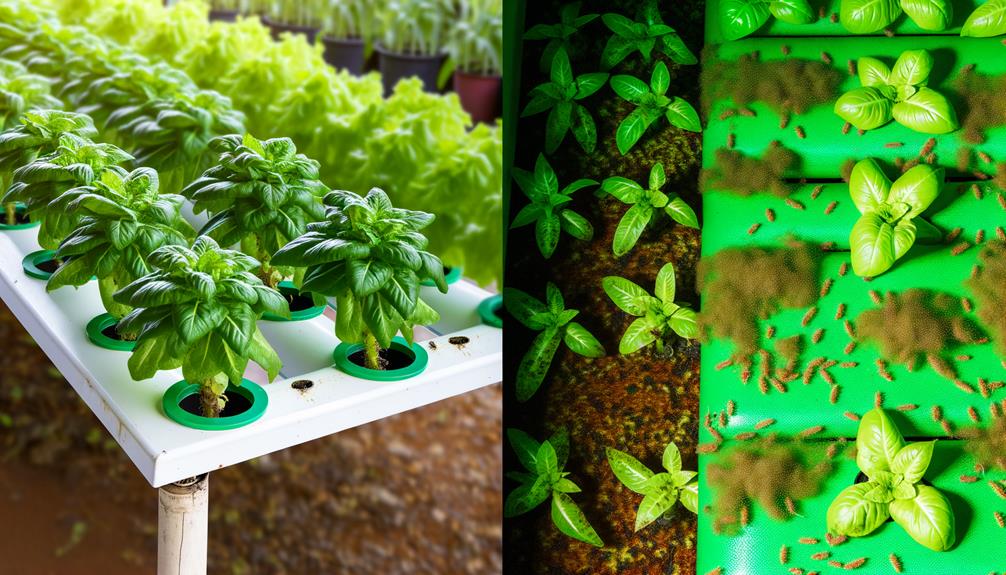
Pest and disease control in hydroponic systems is notably different from soil-based cultivation due to the absence of soil-borne pathogens and the controlled environment inherent to hydroponics.
In hydroponics, the incidence of pests such as nematodes and soil fungi is considerably reduced, leading to lower reliance on chemical pesticides. A 2018 study by the Journal of Plant Pathology noted a 40% decrease in disease occurrence in hydroponic systems compared to soil-based methods.
Additionally, the closed-loop system of hydroponics allows for precise nutrient and pH management, creating conditions less favorable for pathogen proliferation.
Integrated pest management (IPM) strategies, including biological controls and environmental adjustments, are often more effective and sustainable in hydroponic settings, enhancing overall plant health and yield.
Cost Implications
When evaluating the cost implications of hydroponic versus soil-based cultivation, it is essential to take into account initial setup expenses, ongoing operational costs, and long-term economic benefits.
Hydroponic systems often require significant upfront investment, including specialized equipment, nutrient solutions, and infrastructure enhancements. Conversely, soil-based farming generally involves lower initial costs due to the availability of natural resources.
Operational expenses in hydroponics, such as electricity for lighting and water pumps, can be higher, whereas soil cultivation may incur costs related to fertilizers and pest control.
However, hydroponics can offer higher yields per square meter and faster growth cycles, potentially leading to greater profitability over time.
Detailed cost-benefit analysis is critical to determine the most economically viable option.
Environmental Impact

Evaluating the environmental impact of hydroponic versus soil-based cultivation requires an extensive examination of resource consumption, waste generation, and ecological footprint.
Hydroponic systems generally utilize less water, with studies indicating up to a 90% reduction compared to traditional soil methods. However, the energy requirements for artificial lighting and climate control can offset these savings.
Waste production in hydroponics is minimal, as nutrient solutions are recirculated, reducing runoff and leaching. Soil cultivation, conversely, often faces issues with pesticide and fertilizer runoff, contributing to soil degradation and water pollution.
The ecological footprint of hydroponics may be higher due to energy use, but advancements in renewable energy integration could mitigate this impact, making it a viable sustainable option.
Space Efficiency
Space efficiency in hydroponic systems markedly outperforms traditional soil-based agriculture, driven by the potential for vertical farming and the advantages it offers for urban environments.
Data indicates that hydroponic setups can yield up to ten times more produce per square foot compared to soil farming due to optimized space utilization.
This comparative analysis underscores the importance of spatial efficiency in enhancing agricultural productivity within constrained urban settings.
Vertical Farming Potential
Vertical farming, utilizing hydroponic systems, greatly enhances space efficiency by enabling the cultivation of crops in stacked layers, effectively multiplying the yield per unit area compared to traditional soil-based farming.
According to a study by Agrilyst, hydroponic vertical farms can achieve yields up to 10 times greater per square meter than conventional farming methods. This is achieved through optimized plant spacing, controlled environmental conditions, and efficient nutrient delivery systems.
For instance, leafy greens can be grown on multiple vertical tiers, maximizing the use of available vertical space.
Additionally, advancements in LED lighting technology facilitate precise light distribution, further boosting photosynthetic efficiency and crop productivity.
Consequently, vertical hydroponic systems present a compelling solution to the challenges of limited agricultural land and urbanization.
Urban Farming Advantages
Building on the high yield efficiency of hydroponic vertical farming, urban farming presents substantial advantages in optimizing space utilization within densely populated areas.
Through the implementation of vertical stacking systems, urban hydroponic farms can achieve yields up to 10 times greater per square foot compared to traditional soil-based agriculture.
According to recent studies, hydroponic systems can grow crops with a 90% reduction in water usage and a 70% reduction in land usage. This is particularly critical in urban environments where land is scarce and expensive.
Additionally, urban hydroponic farms can be integrated into existing structures such as rooftops and unused buildings, further maximizing spatial efficiency.
Therefore, hydroponics emerges as a transformative approach in urban agricultural practices.
Space Utilization Comparison
Analyzing space efficiency, hydroponic systems demonstrate a considerably higher yield per unit area compared to traditional soil-based methods, largely due to their ability to maximize vertical space and minimize spatial constraints.
This enhanced spatial utilization is pivotal in urban farming and controlled environment agriculture. Key factors contributing to hydroponics' space efficiency include:
- Vertical Farming: Utilizes multi-layered grow systems, increasing plant density per square foot.
- Reduced Root Space: Hydroponic systems require less root space, allowing closer plant spacing.
- Enhanced Environment Control: Precision in nutrient delivery and environmental conditions reduces the need for large horizontal growing areas.
These attributes underscore hydroponics' superiority in space efficiency, making it an ideal choice for maximizing agricultural output in confined spaces.
Crop Variety Options
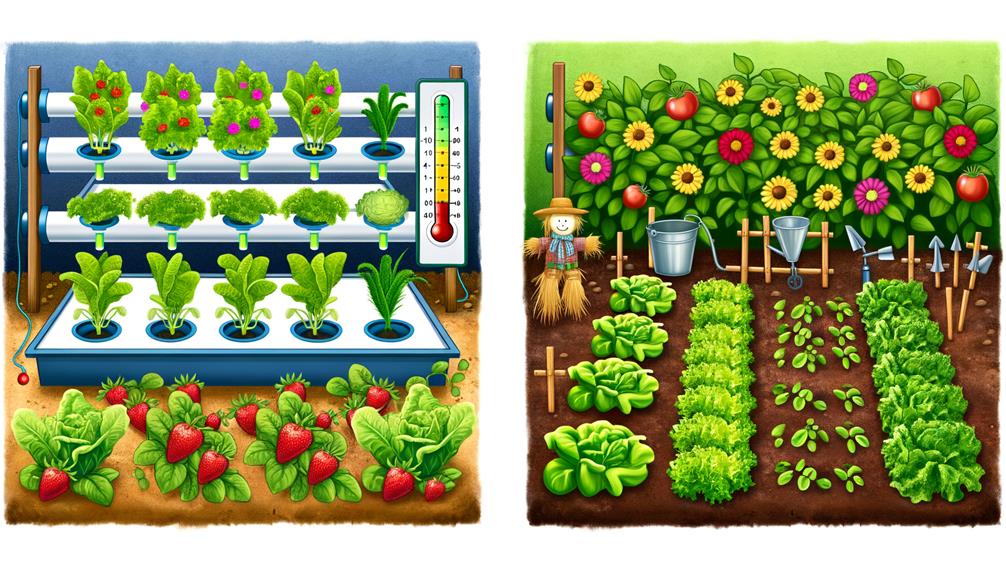
The selection of crop varieties for hydroponic and soil-based systems greatly impacts yield outcomes, necessitating a detailed evaluation of species-specific growth requirements and productivity metrics. Variances in nutrient absorption rates, root architecture, and tolerance to environmental stressors are critical factors influencing the choice of crops. For instance, leafy greens such as lettuce and herbs demonstrate superior yields in hydroponic systems due to enhanced nutrient delivery. Conversely, root vegetables like carrots often perform better in soil, benefiting from natural substrate structure.
| Crop Type | Ideal System |
|---|---|
| Lettuce | Hydroponic |
| Tomatoes | Hydroponic |
| Spinach | Hydroponic |
| Carrots | Soil |
| Potatoes | Soil |
Precise selection aligns crop physiology with system capabilities, maximizing productivity and resource efficiency.
Conclusion
In the intricate dance between hydroponics and soil farming, hydroponics often emerges as a beacon of efficiency and innovation.
The growth rates in hydroponics soar like skyscrapers compared to the gradual ascent seen in soil farming.
Nutrient management in hydroponics operates with surgical precision, while soil farming remains tethered to traditional methods.
Though cost and environmental impacts present challenges, the spatial efficiency and yield potential of hydroponics paint a compelling picture of modern agricultural evolution.


